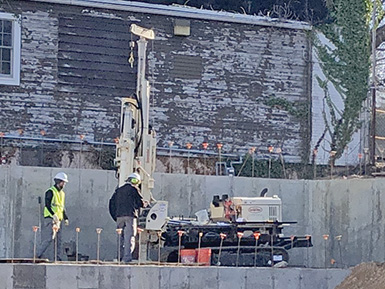
Hotel construction site manager builds soil ramp to allow 7822DT access behind retaining wall in order to conduct DT 325 SPT OTE geotechnical core drilling.
As an environmental/construction consulting and testing firm based on Long Island, New York, JC Broderick & Associates Inc initially focused their subsurface division on environmental sampling. This included Phase II projects such installing monitoring wells and sampling soil/groundwater for contamination. But as their work with school districts in Nassau and Suffolk counties expanded, the balance of environmental to geotechnical core drilling projects began to transform during late 2014 and early 2015.
“There was a time when we were barely doing any geotechnical work and now it’s flipped,” Jeff Nannini, project manager, said. “We’re now 75% geotechnical and 25% environmental.”
When a school district's architect designs a building addition or athletic field renovation, they call on our subsurface division to conduct geotechnical core drilling. They opt for the DT325 driven casing SPT (OTE) method of SPT testing for several reasons:
- worker safety
- consistency
- speed of drilling
- lack of soil disposal
Not only did the DT325 driven casing SPT (OTE) system streamline their changing focus to geotechnical work, but it also made geotechnical core drilling simpler for their clients.
“With OTE, there’s no soil cuttings, which is great at a contaminated site,” Nannini said. “Our clients don’t have to deal with the extra cost of drumming and disposing of soils.”
Additionally, the DT325 driven casing SPT (OTE) system facilitates a seamless shift from environmental to geotechnical work while on a job.
“Using the SPT system on our 7822DT has definitely improved our productivity, since transitioning from casing to sampling only takes moving one lever,” Nannini said. “We already had the 3.25 rods for environmental sampling and 1.5-inch rods for groundwater sampling, so we only had to invest in the automatic drop hammer and split spoon samplers. There was very little additional cost.”
Overall, the DT325 driven casing SPT (OTE) system’s efficiency and reduced contamination during SPT testing is a valuable part of the team’s arsenal.
“At a hotel construction site, engineers were concerned about the soil conditions behind a preexisting retaining wall. The construction manager built us a ramp to get behind the retaining wall to advance two borings using continuous SPT,” Nannini said. “The borings were not unique, but the job could not have been performed without a Geoprobe®. The results of the borings satisfied the engineers that no additional soil improvements were needed.”
Contact Us
1835 Wall Street
Salina, Kansas 67401
Phone: (785) 825-1842

